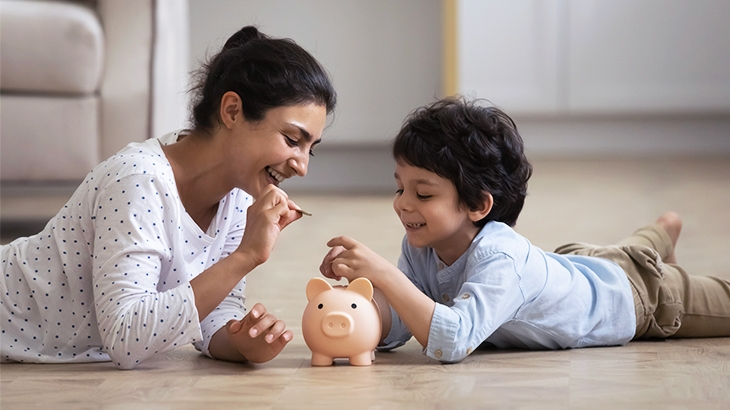Good money habits go a long way. Making intentional decisions to save more and spend less can get easier over time, especially if those habits are learned early on, and make life much less stressful.
If you've got youngsters in your house, then now is an especially valuable time to teach them about the power of good money management.

Consistency is key.
Sure, setting money aside is (relatively) easy when you get a sudden influx of cash (like a birthday check). But to make saving money a big part of your child's future financial routine, you need to make sure they understand that saving money is something that happens every week or month. Opening a secure savings account is the first step.
After you open their savings account with them, make sure you explain that a percentage of all incoming funds will go into that account, whether they come from an allowance, extra chores or birthday cash. Let them know that you do the same with your paycheck(s) - which is how you afforded that vacation last year, new tires on the car or this year's Christmas gifts.
A little bit goes a long way.
If you're consistent about saving money, then it doesn't require a large deposit to get ahead. Walk through a couple sample scenarios with your child to illustrate how powerful even a small amount of money can be over a consistent amount of time. For example, if your child deposits $2 from their weekly allowance into their savings account, they'd have over $100 in the account by the end of the year. That can buy a pretty cool toy or a gently used bike!
If your child is in middle school, talk to them about interest rates and the differences in savings products, like CDs or money markets.
Out of sight, out of mind.
If saving money were easier, then the majority of us probably wouldn't be stressed about it. Let your kids know that saving money is hard, and it's even harder if you have easy access to it, like keeping it in a piggy bank in your room. Readily accessible funds are tempting to spend, which is why it's important for kids to keep the money they're saving in the bank. Out of sight, out of mind!
Safety first.
Opening their first savings account is also a chance to talk about the importance of being safe with money. Talk to your kids about why stuffing money under a mattress or keeping it in a piggy bank may not be the safest option. And make sure to talk about the fact that they're not actually earning any more money (in interest) by keeping it there. Banks are a safe and secure spot to help their money grow.
Work hard now to enjoy more later.
Speaking with your kids about saving is a great opportunity to work in messaging about delayed gratification. Let them know that some of the best things in life—rewarding jobs, relationships, being able to afford a vacation - often require a lot of hard work.
Importance of giving back.
After your child has deposited a sizeable amount of money in their account, then you may want to consider asking them if they'd like to donate some of it towards their favorite charity or cause. For example, you could take them to a grocery store and buy $10 in food items to donate to the local food bank. Or purchase some school supplies that will be used by kids who can't otherwise afford them. It feels good to give back.
While the actual amount of money that's given may be small, the habit of choosing an issue impacting their community and making an effort towards solving that is hugely important, and helps them understand the way that they live isn't necessarily what everyone has.
Start saving.
At WaFd Bank, our Youth Savings account is the perfect tool to help your kids get started. It's only $10 to open and earns interest, and there's no minimum monthly fee. Contact your local branch to find out more today!